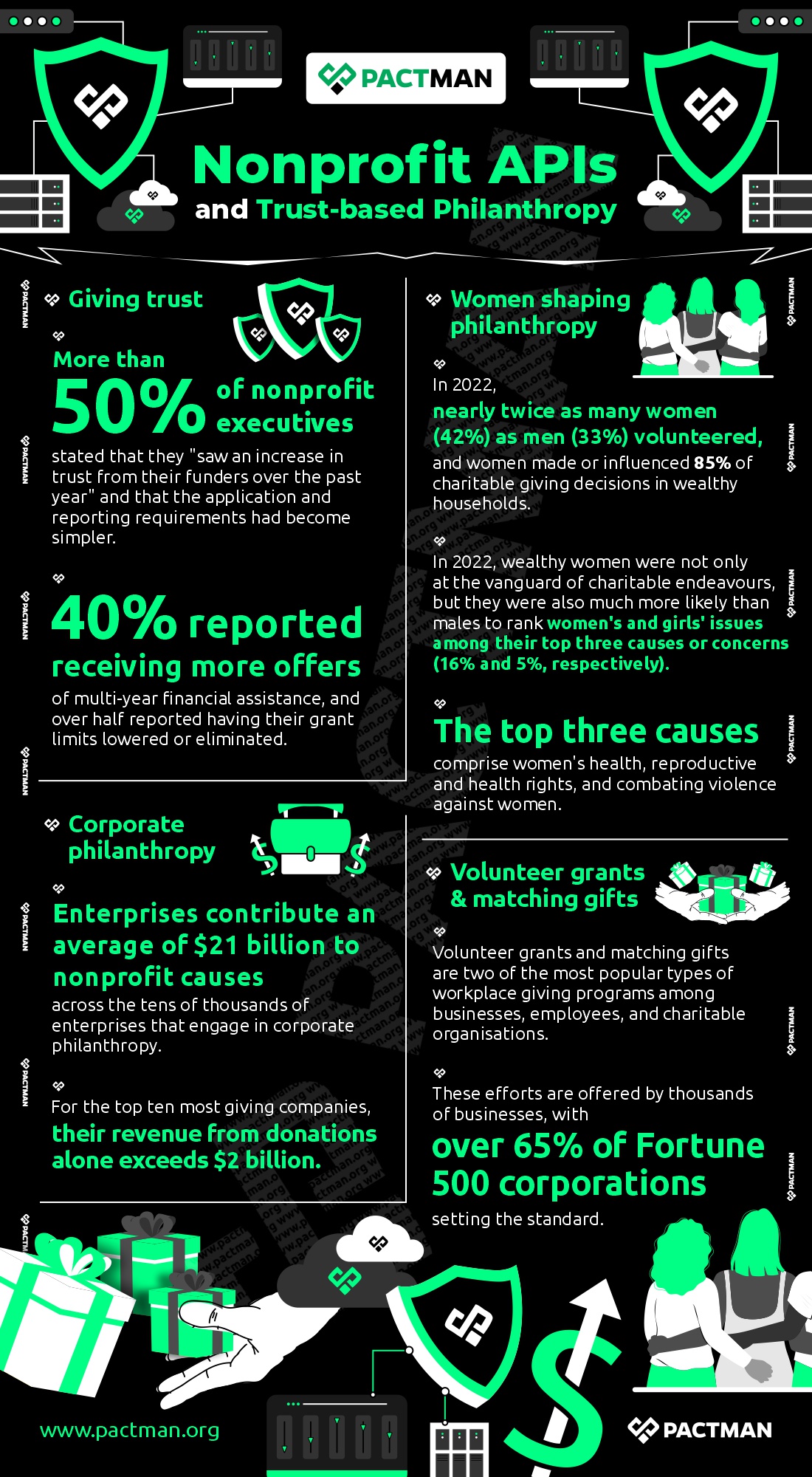I
Introduction
Trust-based philanthropy has redefined the way funders interact with charities. Traditional philanthropy has long been criticised for its secrecy, bureaucratic friction, and power disparities. Likewise, grantmakers frequently impose severe financing rules and expect copious reporting, which breeds mistrust among both donors and grantees. One major obstacle is operationalising trust at scale.

Without returning to extractive systems, how can donors and foundations guarantee due diligence, compliance, and monitoring?
Trust-based philanthropy addresses this paradigm by promoting unfettered funding, simplified applications, and reciprocal accountability. Application Programming Interfaces (APIs) are a silent but potent technological engine at the centre of this evolution. In the nonprofit sector, APIs are bringing about a new era of speed, scalability, and transparency by offering the digital framework necessary for trust to flourish.
Also, APIs are becoming essential tools for matching impact with intent as the industry struggles with the increasing demands for transparency, real-time reporting, and financial equity.
II
What is Trust-based Philanthropy?
Trust-based philanthropy places a major emphasis on establishing relationships of trust between NGOs and their supporters. By emphasising openness, responsibility, and understanding between parties, this strategy helps NGOs use resources efficiently and assist funders in making wise decisions.

Essentially, the philosophical foundations of trust-based philanthropy include stakeholder theory, relational philanthropy, and participatory grantmaking.
Due to evolving donor expectations, technological breakthroughs, and advancing societal demands, philanthropy has seen tremendous changes over time. Transactional giving was a common focus of traditional philanthropy, in which donors would provide money without necessarily knowing the funds or their mission. Nonetheless, this strategy has drawn criticism for its lack of impact, accountability, and openness.
Trust-based philanthropy is more than just a funding mechanism, it is a rethinking of philanthropic purpose. In a society characterised by social disintegration and institutional mistrust, establishing trust is a fundamental skill. At its best, philanthropy is more than just giving money. It is about systems, relationships, and common goals for a better society. Trust serves as the binding agent between them.
By and large, various fundamental ideas form the foundation of trust-based philanthropy, such as:
1. Transparency:
Nonprofits should provide prompt, accurate information about their activities, financial status, and impact.
2. Accountability:
It is important to hold nonprofits responsible for their actions and results.
3. Mutual understanding:
To achieve a thorough understanding of one another’s needs and expectations, donors and NGOs must communicate honestly and openly.
4. Flexibility:
Lastly, funding should be provided by donors in a way that enables organisations to prioritise their activities and adjust to shifting conditions.
As can be seen, both donors and charity organisations can benefit from trust-based philanthropy. Donors can make more informed decisions regarding their giving as it gives them a better grasp of the nonprofit’s mission and impact. Likewise, nonprofits benefit from a steady stream of income, the ability to adjust to shifting conditions, and the opportunity to cultivate enduring connections with donors.
II
Critical Statistics to Consider
In this section, we will consider critical statistics on trust-based philanthropy.
1. Giving trust
A recent analysis from the Centre for Effective Philanthropy (CEP) examined the status of nonprofits’ connections with foundations and individual donors in the early months of 2023. According to the report, more than 50% of nonprofit executives stated that they “saw an increase in trust from their funders over the past year” and that the application and reporting requirements had become simpler.
40% reported receiving more offers of multi-year financial assistance, and over half reported having their grant limits lowered or eliminated.

2. Corporate philanthropy
Enterprises contribute an average of $21 billion to nonprofit causes across the tens of thousands of enterprises that engage in corporate philanthropy. For the top ten most giving companies, their revenue from donations alone exceeds $2 billion.
3. Volunteer grants & matching gifts
Volunteer grants and matching gifts are two of the most popular types of workplace giving programs among businesses, employees, and charitable organisations. These efforts are offered by thousands of businesses, with over 65% of Fortune 500 corporations setting the standard.
4. Women shaping philanthropy
Wealthy women are bringing about positive change through their smart charity and economic clout. In 2022, nearly twice as many women (42%) as men (33%) volunteered, and women made or influenced 85% of charitable giving decisions in wealthy households. In 2022, wealthy women were not only at the vanguard of charitable endeavours, but they were also much more likely than males to rank women’s and girls’ issues among their top three causes or concerns (16% and 5%, respectively). The top three causes comprise women’s health, reproductive and health rights, and combating violence against women.

5. Religious giving
In 2022, wealthy Americans’ charitable contributions were centred on religion. Religion was ranked as one of the top three causes/issues by 22% of wealthy people, and wealthy households continued to donate the greatest percentage of their income to religious groups.
However, the overall proportion of wealthy households contributing to religious institutions has drastically decreased, falling from 47% in 2020 to 39% in 2022.
6. Foundations
The number of foundations in the United States nearly tripled over three decades, from 32,401 in 1990 to 127,595 in 2020. The amount of assets held in those private foundations surged more than twice as quickly, expanding a stunning 693% from $145 billion to $1.2 trillion during the same time.
7. Donor-advised funds
In recent decades, DAFs in the United States have recorded the quickest rate of growth.
According to a report, donations to DAFs grew by 750% in just 15 years, from $10 billion in 2007 to over $86 billion in 2022. Over fifteen years, DAFs’ assets increased by 616%, from little under $32 billion in 2007 to nearly $229 billion in 2022.
8. Individual giving
Giving USA reports that the total amount of money donated by individual donors increased by 12%. Also, last year saw a 9% increase in online giving. An average of $204 was donated online, which was a 15% increase from the previous year.
9. Online giving
Mobile devices accounted for 28% of all online donations. On average, 25% of all online donations made in December went to nonprofit organisations. 22% of all funds raised online came from monthly donations.
First-time donors have a 23% online retention rate. For multi-year donors, the online retention percentage is 64%. Also, giving with a credit or debit card is preferred by 63% of online donors.
IV
Application Programming Interfaces (APIs) as Trust-based Infrastructure
Frequently, APIs are misinterpreted as only technical tools. Far beyond that, they are strategic facilitators of transparency and agility. APIs can create value that has been imprisoned in data silos, thereby lowering operating costs and facilitating ecosystem engagement.

Also, relationships cannot be substituted by APIs. Rather, they help to eliminate procedural friction, helping organisations to prioritise stewardship, strategy, and impact. When properly deployed, APIs can truly promote equity. Even more, APIs level the playing field for organisations by eliminating opaque gatekeeping, automating superfluous paperwork, and providing smaller nonprofits with the same capabilities as larger ones.
For historically underrepresented voices to be heard, the philanthropic infrastructure must be rebuilt. APIs can contribute to this effort when they are made accessible and inclusive.
On the other hand, Trust-based philanthropy is not about letting go of monitoring, but about sharing power via transparency. Rather than replacing trust, APIs in this situation become enablers of trust. Due to cultural reluctance and financial limitations, the nonprofit sector has historically lagged in embracing new technologies. However, APIs have a low entry barrier and offer significant benefits, including decreased friction, increased openness, and enhanced equity. These APIs can strengthen the fundamental pillars of trust between funders and grantees by promoting smooth data interchange, increasing transparency, and simplifying operations, thus promoting a more cooperative and significant philanthropic ecosystem.
Here are effective ways nonprofit APIs can be used to promote trust-based donations:
a. Simplified Application and Reporting:
By integrating grant management systems, APIs enable organisations to send reports in standardised formats that funders can simply process. APIs auto-populate application fields with organisational data that already exists (for example, Candid or Guidestar APIs).
b. Enhanced Transparency and Accountability:
Secondly, APIs can enable the exchange of impact data and financial information in real-time. This can greatly minimise the administrative load on grantees and free up time and resources for work that is crucial to the mission. To provide a transparent view of progress without requiring manual data entry, a nonprofit may use a program management platform with an open API to automatically feed key performance indicators into a funder’s dashboard. This promotes a shared accountability culture founded on understandable, easily accessible facts.
c. Encouraging Risk Assessment and Due Diligence:
Although trust-based philanthropy places a strong emphasis on trust, it does not eliminate the necessity of prudent financial management. Funders can obtain verified nonprofit data through APIs, including compliance information, financial health indicators, and legal status (e.g.through Pactman Nonprofit Checkplus API). This enables effective due diligence, fostering funder trust without subjecting grantees to unduly onerous procedures.
d. Facilitating Collaborative Learning and Impact Measurement:
By allowing funders and grantees to integrate disparate data sources and analytical tools, APIs facilitate collaborative trend analysis, improvement identification, and impact measurement. To illustrate the scope and efficacy of initiatives in specific localities, APIs may, for instance, combine information from various nonprofit databases with geographic information systems (GIS).
e. Promoting Innovation and Resource Sharing:
Open APIs have the potential to stimulate the creation of cutting-edge platforms and solutions that benefit the charitable industry as a whole. For example, an API for in-kind donations can easily match needs with resources, while a shared API for volunteer management could link people with pertinent opportunities across several NGOs.
Nonetheless, it is imperative to recognise possible obstacles and moral dilemmas. Leveraging APIs to their full potential in a way that genuinely advances the ideas of trust-based philanthropy requires careful planning and control. For philanthropic organisations to fully utilise APIs, they must view them as essential elements of their digital trust strategy rather than as technological add-ons. Nonprofit APIs can link funders, grantees, data suppliers, and other players in the nonprofit sector, resulting in a more cohesive and effective ecosystem.
V
Difficulties and Challenges to Consider
More foundations started moving toward flexible funding and simpler reporting during the pandemic. Trust-based philanthropy codifies this movement into long-term practice. Now more than ever, foundations and donors are adopting technology, particularly nonprofit APIs, to operationalise trust, promote data-driven decision-making, and expand giving. This is especially with the need to decentralise power, lessen administrative costs, and increase impact.

However, despite the obvious benefits that APIs and trust-based philanthropy offer, their confluence also poses difficult challenges such as:
- Ethical Consent and Data Use
APIs collect, compile, and disseminate private nonprofit data. Consequently, this could perpetuate prejudices or misrepresent organisations if it is not carefully governed. Hence, grantee input and ethical guidelines must direct the use of APIs.
- The Digital Divide
Not every nonprofit organisation has equal access to digital resources. It is imperative for foundations to ensure that smaller, grassroots organisations without access to technology are not disadvantaged by API-driven platforms.
- Juxtaposition of Speed and Responsibility
Automated procedures can speed up donations. However, they run the danger of omitting crucial contextual analysis. Accordingly, technology efficiency must not overshadow local expertise and strategic alignment.
All in all, data security and privacy must be given priority when implementing nonprofit APIs. Equal access for organisations with different technological capabilities must also be guaranteed, and algorithmic decision-making must not reinforce pre-existing biases. The grantmaking and philanthropic ecosystem has entered a new era of openness, agility, and equity with the convergence of nonprofit APIs and trust-based philanthropy (TBP).
VI
The Road Ahead: Creating an API-Native Trust Economy
The future is indicated by the convergence of trust-based philanthropy and APIs, where:
- Grants are awarded in hours rather than weeks.
- Verification is embedded, rather than requested.
- Power is not hoarded; it is shared.
- Impact is anchored on relationships, not reports.

In this future, foundations serve as network nodes rather than as a central authority. Also, rather than acting as gatekeepers, donors act as data stewards. And rather than displacing trust, technology becomes a subdued enabler that increases it. Nowadays, philanthropy is about how we hold the process rather than who owns the money.
Also, several global and micro developments are pushing the alignment of APIs with trust-based philanthropy.
1. Digital transformation:
More than charitable institutions in the United States are implementing some type of digital infrastructure to manage grants and track impact. APIs are at the heart of this evolution, providing real-time workflows, integrations, and dashboards.
2. The emergence of the philanthropic movement:
Funds focused on equity and social justice are thriving, with programs like the Emergent Fund and Borealis Philanthropy promoting quick, adaptable funding. The bureaucratic obstacles of delivering funding to address these urgent concerns are lessened by APIs.
3. Regulatory Pressure:
Due to increased IRS and financial regulator scrutiny, grantmakers must demonstrate that they are supporting lawful 501(c)(3) organisations and abiding by anti-money laundering (AML) regulations. A large portion of this verification is automated using APIs, which lowers the possibility of legal issues.
4. Trust Deficit and Donor Scepticism:
Trust in traditional institutions continues to erode. APIs provide verifiable, auditable records that mitigate donor scepticism.
The combination of nonprofit APIs and trust-based fundraising is more than just a technical innovation; it represents a fundamental change. It shifts charity from paternalism to collaboration, opacity to transparency, and bureaucracy to agility. Looking ahead, we predict three trends:
- Trust indicators Will Change:
Expect a new trust taxonomy in which APIs report not only 501(c)(3) status but also community input, board diversity, and equity indicators.
- Smart Contracts in Philanthropy:
Blockchain-enabled smart contracts may use APIs to conditionally make funding based on trust indicators and social milestones rather than outputs.
- Embedded Philanthropy:
APIs will enable philanthropy to be integrated into payroll systems, e-commerce, and financial products. Just picture making a compliant, automatic donation to a verified grassroots nonprofit with each credit card swipe or ride-share transaction.
Together, trust-based philanthropy and APIs serve as the foundation and philosophy for this subsequent stage.
Conclusion
We stand at a crossroads. One path continues in the status quo: transactional, extractive, and imbalanced. The other path, though less traveled, offers an opportunity to build a philanthropic sector that is resilient, equitable, and transformational. In the final analysis, Trust-Based Philanthropy is both a strategic framework and a moral philosophy.
A key component of the future of trust-based giving is the smart use of nonprofit APIs. With its promise of increased equity, impact, and real cooperation, the move to trust-based philanthropy signifies a fundamental change in the sector’s power dynamics. In addition to being a technological extension of this movement, nonprofit APIs are an essential component of the infrastructure that can operationalise trust.
By adopting the API imperative, giving can transcend the antiquated norms of control and compliance. This will shift the sector toward a future where technology acts as a catalyst for revolutionary social change, transparency builds trust, and data facilitates cooperation.
Register for your free Nonprofit Check Plus API Account today.



One Response